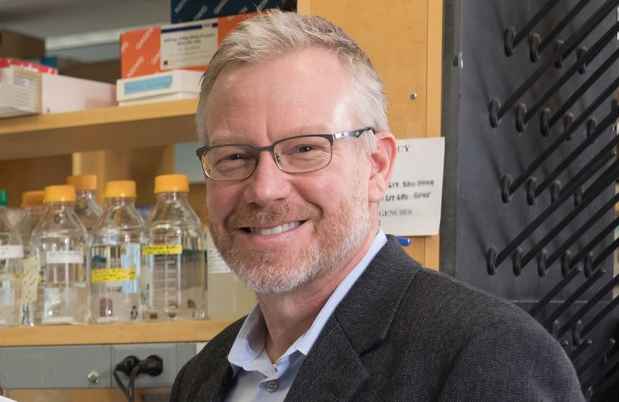Neuroscience Research at McLean
A Look Inside Our Work to Understand the Body’s Most Complex Organ
Basic Neuroscience Investigates How the Brain Works
Through laboratory experiments, observations and testing, and the development of computer models, neuroscientists examine the fundamental mechanisms of the brain, allowing us to see how the brain functions when healthy. Their work also helps us understand how the brain works when disorders like schizophrenia, depression, and addiction are present.
Basic neuroscience research lays the foundation for treatments that can prevent or fix the many psychiatric and neurological diseases that affect the brain. The creation of effective approaches to treating these diseases would be impossible without detailed understanding of the complex systems underlying normal brain function and what goes wrong when the brain is not working as it should. Working closely with clinical experts, basic neuroscientists help further the development and testing of new efficient treatments for mental illnesses.
With this in mind, basic neuroscientists focus on gaining deeper insight into the functions of different parts of the brain, what those parts control, and what can go wrong to produce a mental illness. For example, researchers at McLean Hospital are studying genetic and biological data collected from human subjects to see how they may relate to PTSD, anxiety, and similar conditions. Others are conducting tests on the neurobiological mechanisms of rodent brains to determine possible differences in drug addiction between men and women.
These and many other ongoing investigations inform progress in the closely related fields of psychiatry and neuroscience. Until neuroscientists figure out which part of the brain causes a condition, it is unlikely that researchers can find cures or develop preventative measures. Without studies into the complex mysteries of how the brain works, scientists couldn’t develop effective medications or therapies that target specific areas in the brain to help individuals with mental health diagnoses.
The field of neuroscience is ever-changing. Scientific studies conducted in laboratories at McLean and around the world are making groundbreaking progress in discovering the causes and cures of mental health disorders with the goal of innovative progress, from laboratory benchtop to patient bedside.
The Human Brain Is a Fascinating Organ
Weighing in at around three pounds, the human brain is far more powerful than the most powerful computer. Every second, the brain processes hundreds of billions of bits of information. The brain’s 100 billion neurons send signals that allow us to communicate, make plans, solve problems, detect threats, protect ourselves, remember, reason, and engage in the world around us. When brain functions are altered, mental health and neurological disorders are present. Irregular brain function can affect judgment, communications, emotions, behavior, and our understanding of what is real and what is not.
Things you may not know about the human brain:
- 60% of the brain is made up of fat; it is one of the fattiest organs in the body
- The human brain can generate approximately 23 watts of power when awake
- The brain receives 20% of the total blood and oxygen produced in our body
- Blood vessels in the brain run almost 100,000 miles in length
- In early pregnancy, the brain creates 250,000 new neurons per minute
- Humans formally started studying the brain around 70 AD
Basic Neuroscience at McLean
McLean Hospital is a leading research institution for basic neuroscience studies. Investigators gain insight into the causes of mental illness and neuropsychiatric and neurodevelopmental disorders by using cutting-edge approaches and technology to maximize discovery and accelerate translation of findings.
Covering many different aspects of brain function, researchers in McLean’s Jerry and Phyllis Rappaport Center of Excellence in Basic Neuroscience Research take unique approaches to better understand brain functioning and support the development of new treatments. Current and past studies have investigated cellular and molecular mechanisms of learned and innate behaviors, the use of new technologies for cognitive assessment (the study of thinking and reasoning skills), and the biology behind conditions like depression.

Unlike many research-focused institutions, McLean focuses equally on patient care and psychiatric research. According to Kerry J. Ressler, MD, PhD, McLean’s chief scientific officer, “McLean is able to lead 21st century neuropsychiatric research due to its integration of world-class treatment and innovative, cutting-edge research programs—all on the same campus.”
McLean is proud to be home to more than 300 neuroscience researchers. Some of McLean’s neuroscientists take a narrow-focus approach, attempting to understand everything there is to know about how, where, when, and why a particular gene or brain circuit works. They then look to see how those genes or circuits affect behavioral outcomes relevant to mental health conditions. Other researchers take a broader approach, working to understand how populations of cells or genes in the brain work together under both healthy and unhealthy conditions.
Regardless of approach, researchers at McLean band together to offer their expertise to further a larger effort to understand the brain on many levels. Over the years, knowledge and insight derived from the work of McLean’s basic neuroscientists has helped in the development of effective treatments for conditions such as anxiety, depression, drug addiction, schizophrenia, and neurodegenerative diseases.
Joseph T. Coyle, MD: A Scientific Journey
The path from basic neuroscience research to viable treatment can be a long one. Such was the case with the work of Dr. Joseph Coyle and his Laboratory for Psychiatric and Molecular Neuroscience concerning schizophrenia.
As one of the most successful examples of a journey from benchtop investigation to clinical research to improved treatment outcomes, Dr. Coyle’s work primarily focused on understanding the negative symptoms of schizophrenia, symptoms such as social isolation, lack of initiative, socially awkward behavior, and cognitive deficits. Because most medications do not treat these symptoms, and these symptoms tend to have the biggest negative impact on a patient’s quality of life over time, these symptoms are thought to be the most debilitating to people who struggle with the condition.
To address the problem, Dr. Coyle and his group took advantage of findings in the 1990s revealing that drugs that block glutamate NMDA receptors can produce symptoms (both positive and negative) that are initially indistinguishable from schizophrenia. Found in the membrane of nerve cells, glutamate NMDA receptors are proteins that are believed to play an important role in learning and memory.
Building on this work, Dr. Coyle and his colleagues performed molecular, genetic, and behavioral experiments in genetically engineered mouse models. These experiments have shown that enhancing NMDA receptor function with a naturally occurring chemical in the brain called D-serine improves most of the schizophrenic-like behaviors observed in these mouse models.
This and other work led to numerous clinical trials with human subjects with Dr. Coyle’s clinical collaborators throughout the country. These trials showed that D-serine and similar compounds administered in conjunction with other antipsychotic medications significantly reduces both the positive and negative symptoms of schizophrenia.
Although this work has not cured schizophrenia, it has allowed clinicians to effectively and proactively treat some of the negative symptoms that emerge prior to the first psychotic break, and it has completely changed the way scientists at all levels view the potential root causes of schizophrenia. Overall, Dr. Coyle’s work has already improved treatment outcomes while at the same time stimulating future basic neuroscience research into how NMDA receptor dysfunction may be at the root of schizophrenia.
“Research and clinical treatment take place side by side at McLean, enabling cross-collaboration and facilitation of scientific discoveries that have true meaning for the conditions we treat.”– Bill Carlezon, PhD, chief of the Jerry and Phyllis Rappaport Center of Excellence in Basic Neuroscience Research
Elena Chartoff, PhD: Exploring Gender Differences in Addiction
How does the brain produce negative affective states—states in which people feel generally negative about themselves and the world around them—that contribute to psychiatric disorders, and do these brain mechanisms differ between males and females?
These are the overarching questions addressed at Dr. Elena Chartoff’s Neurobiology of Motivated Behavior Laboratory.
To answer these questions, Dr. Chartoff and her colleagues probe the sex-dependent neurobiological mechanisms underlying drug withdrawal. They also look at how stressful situations experienced early in life impact negative emotional states. In both cases, Dr. Chartoff and her colleagues look at how these factors contribute to addictive behavior in rodent models.
Their work is divided into two components, both directed at understanding the underlying brain mechanisms. First, Dr. Chartoff and her team study how opioid dependence modulates dopamine and glutamate signaling in the nucleus accumbens. The nucleus accumbens is a part of the brain associated with “rewarding” behavior like eating, sexual activity, or taking drugs. Dopamine neurons and other neurons are activated in the nucleus accumbens in response to this type of behavior.
These studies have revealed mechanisms in the brain that can be targeted with medications to help decrease opioid withdrawal-induced negative affective states. Ultimately, targeting these mechanisms can reduce drug taking, craving, and relapse.
The second component of the Chartoff lab’s research is studying how certain endogenous opioids, naturally occurring chemicals released by the body that normally react with the brain to produce a positive feeling, and their receptors—in this case, neuropeptide dynorphin and the kappa opioid receptor (KOR)—act within the brain to produce negative affective states in response to chronic drug exposure or early-life stress. The lab was one of the first to show that activating KORs with certain medications prevents the ability to feel pleasure (anhedonia) and increases stress sensitivity in cocaine-withdrawn rats. Furthermore, the lab has shown that female rats are less sensitive than males to the anhedonic effects of KOR activation. Given the higher rates of depressive-like disorders in women, these findings suggest that different neurobiological mechanisms underlie negative affect in males and females.
Understanding the neurobiology of negative affective states has implications far beyond drug addiction, as they are some of the most debilitating symptoms of most mental illnesses, including depression, schizophrenia, bipolar disorder, and even neurodegenerative disorders such as Parkinson’s disease. Dr. Chartoff hopes to collaborate with other investigators and leverage the lab’s unique combination of behavioral and molecular expertise to improve treatments for individuals experiencing negative emotional states.
Kerry J. Ressler, MD, PhD: The Basis of Fear
Utilizing genetic and other biological data collected from human clinical populations, Dr. Kerry Ressler and his team at the Neurobiology of Fear Laboratory identify genetic traits and neural processes (the way a neuron achieves a given task) that may contribute to the underlying causes of fear- and anxiety-based illnesses such as PTSD. The researchers hope that gaining an understanding of how fear works in the mechanisms of the brain will contribute to the development of novel treatments, and possibly even prevention, of fear-based psychiatric illnesses.

Through an integration of animal models of fear learning and human genetic research, the Ressler Lab investigates the many mechanisms underlying fear processes. The lab uses mouse models to examine different aspects of fear learning. These models allow for investigation into the role of different brain regions in fear processing.
In addition, Ressler and his colleagues examine how these mechanisms may be involved in the development of fear-based disorders in humans, such as PTSD, phobic disorders, and panic disorder. For this work, the team uses data collected from human clinical populations to identify genetic traits and neural processes that may contribute to the development of these illnesses and provide us with novel targets, new areas of the brain to study or treat a specific disease or symptom, for research using animal models.
Building on the Past, Looking to the Future
McLean Hospital is committed to providing comprehensive care for individuals with mental health conditions. Over the years, McLean researchers have contributed greatly to the understanding of brain function, and these contributions have led to new or improved approaches to treating various mental health diagnoses.
Daily, McLean’s scientists and support staff are conducting innovative studies with the goal of eventual prevention and cures.
With a research portfolio that encompasses a variety of approaches and collaborations, McLean’s Rappaport Center of Excellence in Basic Neuroscience continues to have a powerful impact on treatment for mental health disorders, leading to better outcomes and better lives for those living with mental illness.
Learn More
You may find this additional information to be helpful:
- Read issues of Discovery @ McLean Hospital, McLean’s research publication
- Find articles about the latest in neuroscience news and discovery
- Meet some of our expert investigators and neuroscientists
- Learn about McLean’s Rappaport Center of Excellence in Basic Neuroscience
- Read about neuroscience press coverage in the media
- Explore more information about basic neuroscience at McLean
- Watch these videos about working in research at McLean
Glossary
Neuroscience
Neuroscience is a field that investigates how the nervous system functions and how its functions affect behavior and cognition. Neuroscientists primarily study the brain, and their work often intersects with fields like psychology, medicine, linguistics, and computer science.
Central nervous system
The brain and the spinal cord make up the central nervous system. This system is a kind of “command center” for the body, controlling functions such as breathing, body temperature, and heart rate, as well as all thoughts and feelings.
Neuron
A neuron is a nerve cell that sends and receives electrical and chemical signals in the body. Sensory neurons carry external information—such as information received by eyes, ears, nose, mouth, fingertips—to the central nervous system. Information from the central nervous system is transmitted to the muscles, skin, and other organs by motor neurons. Neurons within the brain and spinal cord are connected by interneurons. There are about 100 billion neurons in the human brain.
Cortex
Also known as the cerebrum, the cortex is the largest part of the human brain. Located on the outermost part of the brain, the cortex is made up of four sections: the frontal lobe, parietal lobe, occipital lobe, and temporal lobe.
Frontal lobe
Located in the frontal and upper portion of the brain’s cortex, the frontal lobe controls the brain’s more complex functions, such as thinking, memory, planning, and problem solving.
Hippocampus
Part of the brain’s temporal lobe, the hippocampus plays a role in spatial navigation, long-term memory, and the regulation of emotions.
History of Neuroscience
No doubt, humans have attempted to understand the nature of thinking, dreaming, and consciousness for as long as there have been humans. Formal studies of the brain are believed to have begun around 70 BC with the Roman physician Galen. He put forth the idea that the brain controls moods as well as the body’s functions. Over the years, brain studies became more advanced. Treatments for mental illnesses were described in a medical textbook by Abu al-Qasim al-Zahrawi in 1000 AD, and neuroscience was addressed in Andreas Vesalius’s “On the Workings of the Human Body,” published in 1543. The 1664 book “Anatomy of the Brain,” by Thomas Willis, introduced the term “neurology” and discussed reflexes, epilepsy, apoplexy, and paralysis.
From the 1800s to the present, studies of the brain have expanded and accelerated. From the advent of neurosurgery to the introduction of EEG (electroencephalography) to measure electrical activity in the brain, to the development of magnetic resonance imaging (MRI), brain research has increased our knowledge of healthy brain function and given us tremendous insights into mental illness.
McLean Hospital is home to the nation’s oldest and foremost research program in a psychiatric hospital setting, and since 1888, it has been dedicated to studying the role of biological factors in mental illness.
Still, the brain remains a complex and mysterious organ. The work continues.



